




zł159.16 tax excl.
At the Feather M0's heart is an ATSAMD21G18 ARM Cortex M0 processor, clocked at 48 MHz and at 3.3V logic, the same one used in the new Arduino Zero. This chip has a whopping 256K of FLASH (8x more than the Atmega328 or 32u4) and 32K of RAM (16x as much)! This chip comes with built in USB so it has USB-to-Serial program & debug capability built in with no need for an FTDI-like chip. Adafruit 3179
Feather is the new development board from Adafruit, and like its namesake it is thin, light, and lets you fly! We designed Feather to be a new standard for portable microcontroller cores.
This is the Adafruit Feather M0 RFM96 LoRa Radio (433 MHz) - our take on an microcontroller with a "Long Range (LoRa)" packet radio transceiver with built in USB and battery charging. Its an Adafruit Feather M0 with a 433MHz radio module cooked in! Great for making wireless networks that are more flexible than Bluetooth LE and without the high power requirements of WiFi.
At the Feather M0's heart is an ATSAMD21G18 ARM Cortex M0 processor, clocked at 48 MHz and at 3.3V logic, the same one used in the new Arduino Zero. This chip has a whopping 256K of FLASH (8x more than the Atmega328 or 32u4) and 32K of RAM (16x as much)! This chip comes with built in USB so it has USB-to-Serial program & debug capability built in with no need for an FTDI-like chip.
To make it easy to use for portable projects, we added a connector for any of our 3.7V Lithium polymer batteries and built in battery charging. You don't need a battery, it will run just fine straight from the micro USB connector. But, if you do have a battery, you can take it on the go, then plug in the USB to recharge. The Feather will automatically switch over to USB power when its available. We also tied the battery thru a divider to an analog pin, so you can measure and monitor the battery voltage to detect when you need a recharge.
This Feather M0 LoRa Radio uses the extra space left over to add an RFM9x LoRa 868/915 MHz radio module. These radios are not good for transmitting audio or video, but they do work quite well for small data packet transmission when you need more range than 2.4 GHz (BT, BLE, WiFi, ZigBee).
Our initial tests with default library settings: over 1.2mi/2Km line-of-sight with wire quarter-wave antennas. (With setting tweaking and directional antennas, 20Km is possible).
Comes fully assembled and tested, with a USB bootloader that lets you quickly use it with the Arduino IDE. We also toss in some headers so you can solder it in and plug into a solderless breadboard. You will need to cut and solder on a small piece of wire (any solid or stranded core is fine) in order to create your antenna. Lipoly battery and USB cable not included.
Data sheet
Manufacturer BTC Korporacja sp. z o. o. Lwowska 5 05-120 Legionowo Poland sprzedaz@kamami.pl 22 767 36 20
Responsible person BTC Korporacja sp. z o. o. Lwowska 5 05-120 Legionowo Poland sprzedaz@kamami.pl 22 767 36 20
The board is equipped with ATSAMD21 microcontroller with ARM Cortex-M0 core and SPI Flash memory, GPIO pins and RGB diode. Adafruit 3505
Development board with AVR ATmega328 microcontroller with a clock signal of 16 MHz. Compatible with Arduino, it is equipped with a STEMMA QT connector. Adafruit 5597
Tiny (18 x 44 mm) breadboard-friendly development board, easy to use, hacker friendly. ATmega328 brains32KB of flash (1/2 K is reserved for the bootloader), 2KB of RAM, clocked at 16MHz. Adafruit 2590
Small development kit with ATmega32u4 microcontroller. The board has 6 power, 6 analog and 17 digital pins, which makes it have similar capabilities to the Arduino UNO. Compatible with Arduino. Adafruit 3677
Based on the versatile ATmega328, the Metro Mini packs 32KB Flash, 2KB RAM, a clock speed 16Mhz and the Optiboot bootloader. The slick black and gold unit includes 20 GPIO pins. Adafruit 2488
No product available!
Adafruit 1500
Adafruit Trinket - Mini Microcontroller - 5V Logic
Plate from the Adafruit Feather series equipped with an ATmega32u4 microcontroller and a small prototype surface (5x7). The chip contains 32KB flash memory, 2KB RAM memory and built-in USB support. The plate is compatible with Arduino. Adafruit 2771
FLORA is Adafruit\'s fully-featured wearable electronics platform. It\'s a round, sewable, Arduino-compatible microcontroller designed to empower amazing wearables projects. Adafruit 659
Small development kit with ATmega32u4 microcontroller. The board has 6 power, 6 analog and 17 digital pins, which makes it have similar capabilities to the Arduino UNO. Compatible with Arduino. Adafruit 3675
No product available!
The board is equipped with ATSAMD51 microcontroller with ARM Cortex-M4 core and SPI Flash memory, communication interfaces and RGB diode. Adafruit 3382
GEMMA M0 is an intelligent clothing controller from Adafruit. In relation to the classic GEMMA board, it was equipped with a 32-bit ATSAMD21E18 microcontroller (based on Cortex M0 +). It has GPIO pins, RGB DotStar diode. The board can be powered by a 3.7 V Li-Ion battery (JST connector). Adafruit 3501
No product available!

At the Feather M0's heart is an ATSAMD21G18 ARM Cortex M0 processor, clocked at 48 MHz and at 3.3V logic, the same one used in the new Arduino Zero. This chip has a whopping 256K of FLASH (8x more than the Atmega328 or 32u4) and 32K of RAM (16x as much)! This chip comes with built in USB so it has USB-to-Serial program & debug capability built in with no need for an FTDI-like chip. Adafruit 3179
